Effects of Combined Application of Organic Fertilizer on the Growth and Yield of Pakchoi under Different Irrigation Water Types
Abstract
:1. Introduction
2. Materials and Methods
2.1. Experimental Site and Description
2.2. Experimental Design and Field Management
2.3. Measurements and Calculations
2.3.1. Pakchoi Growth Index
2.3.2. Pakchoi Growth Model Based on Cumulative Growing Degree Days
2.4. Data Processing Method and Error Analysis
3. Results
3.1. Evaluation of Growth Index Logistic Model Fitting
3.2. Dynamic Characteristics of Growth Index
3.3. Relationship between Yield Composition and Logistic Model Characteristics Parameters
4. Discussion
4.1. Effects of Combined Application of Organic Fertilizer on Growth Indexes and Dynamic Characteristics
4.2. The Relationship between Characteristic Parameters of Logistic Model and Structural Equation Model
5. Conclusions
Author Contributions
Funding
Data Availability Statement
Conflicts of Interest
Appendix A
| Index | Treatment | 2022 | 2023 | ||||||||||||
|---|---|---|---|---|---|---|---|---|---|---|---|---|---|---|---|
| CGDD0 | CGDD1 | CGDD2 | ΔCGDD | Vmax | Vavg | YVmax | CGDD0 | CGDD1 | CGDD2 | ΔCGDD | Vmax | Vavg | YVmax | ||
| PH | F0 | 537.92 | 296.31 | 779.54 | 483.23 | 0.042 | 0.037 | 15.43 | 471.14 | 228.29 | 713.99 | 485.69 | 0.042 | 0.037 | 15.38 |
| F1 | 488.26 | 239.70 | 736.82 | 497.12 | 0.051 | 0.045 | 19.41 | 463.28 | 214.96 | 711.60 | 496.64 | 0.051 | 0.045 | 19.22 | |
| F2 | 513.02 | 259.88 | 766.16 | 506.28 | 0.053 | 0.046 | 20.20 | 491.09 | 236.96 | 745.21 | 508.24 | 0.052 | 0.046 | 20.09 | |
| F3 | 520.87 | 258.95 | 782.79 | 523.84 | 0.049 | 0.043 | 19.34 | 499.24 | 227.33 | 771.14 | 543.82 | 0.047 | 0.041 | 19.38 | |
| F4 | 523.24 | 261.13 | 785.34 | 524.21 | 0.046 | 0.040 | 18.26 | 474.85 | 215.69 | 734.01 | 518.32 | 0.045 | 0.039 | 17.71 | |
| B0 | 450.09 | 178.19 | 721.99 | 543.80 | 0.026 | 0.023 | 10.87 | 478.51 | 217.02 | 739.99 | 522.97 | 0.028 | 0.025 | 11.18 | |
| B1 | 441.46 | 151.06 | 731.85 | 580.80 | 0.033 | 0.029 | 14.62 | 471.55 | 165.18 | 777.92 | 612.74 | 0.031 | 0.027 | 14.53 | |
| B2 | 430.22 | 133.27 | 727.18 | 593.91 | 0.037 | 0.033 | 16.83 | 480.03 | 200.06 | 760.00 | 559.94 | 0.041 | 0.036 | 17.45 | |
| B3 | 389.93 | 136.09 | 643.77 | 507.68 | 0.060 | 0.053 | 23.29 | 526.27 | 272.49 | 780.04 | 507.56 | 0.060 | 0.053 | 23.14 | |
| B4 | 393.15 | 104.06 | 682.24 | 578.18 | 0.043 | 0.038 | 18.93 | 432.41 | 162.78 | 702.05 | 539.27 | 0.047 | 0.041 | 19.08 | |
| MIB0 | 484.72 | 224.06 | 745.38 | 521.32 | 0.045 | 0.039 | 17.71 | 488.10 | 237.59 | 738.61 | 501.02 | 0.046 | 0.040 | 17.57 | |
| MIB1 | 457.69 | 197.77 | 717.62 | 519.85 | 0.056 | 0.049 | 21.96 | 449.14 | 157.90 | 740.37 | 582.47 | 0.050 | 0.044 | 22.23 | |
| MIB2 | 472.60 | 183.65 | 761.54 | 577.89 | 0.044 | 0.038 | 19.09 | 453.79 | 167.84 | 739.73 | 571.88 | 0.044 | 0.039 | 19.08 | |
| MIB3 | 346.45 | 63.41 | 629.49 | 566.08 | 0.053 | 0.046 | 22.65 | 432.32 | 163.63 | 701.00 | 537.37 | 0.056 | 0.049 | 22.94 | |
| MIB4 | 427.03 | 112.85 | 741.22 | 628.36 | 0.031 | 0.027 | 14.92 | 422.49 | 127.79 | 717.20 | 589.41 | 0.035 | 0.031 | 15.76 | |
| LAI | F0 | 893.82 | 702.51 | 1085.13 | 382.62 | 0.013 | 0.012 | 3.81 | 779.97 | 586.78 | 973.16 | 386.38 | 0.013 | 0.012 | 3.95 |
| F1 | 770.97 | 576.90 | 965.03 | 388.12 | 0.016 | 0.014 | 4.68 | 764.41 | 565.38 | 963.44 | 398.06 | 0.016 | 0.014 | 4.81 | |
| F2 | 732.68 | 538.96 | 926.40 | 387.44 | 0.014 | 0.012 | 4.12 | 714.53 | 520.55 | 908.51 | 387.96 | 0.014 | 0.012 | 4.12 | |
| F3 | 712.13 | 511.57 | 912.70 | 401.13 | 0.015 | 0.013 | 4.51 | 716.29 | 484.23 | 948.35 | 464.12 | 0.013 | 0.012 | 4.70 | |
| F4 | 909.48 | 698.80 | 1120.17 | 421.37 | 0.014 | 0.012 | 4.40 | 866.68 | 654.85 | 1078.52 | 423.68 | 0.014 | 0.012 | 4.57 | |
| B0 | 924.61 | 742.08 | 1107.15 | 365.07 | 0.013 | 0.011 | 3.57 | 853.56 | 650.95 | 1056.18 | 405.23 | 0.013 | 0.011 | 3.96 | |
| B1 | 839.58 | 656.00 | 1023.16 | 367.16 | 0.017 | 0.015 | 4.76 | 833.98 | 626.43 | 1041.52 | 415.08 | 0.014 | 0.012 | 4.28 | |
| B2 | 1033.54 | 821.26 | 1245.82 | 424.56 | 0.011 | 0.010 | 3.61 | 833.71 | 611.45 | 1055.97 | 444.52 | 0.014 | 0.012 | 4.78 | |
| B3 | 698.99 | 499.65 | 898.32 | 398.67 | 0.015 | 0.013 | 4.65 | 687.83 | 450.32 | 925.33 | 475.01 | 0.013 | 0.011 | 4.62 | |
| B4 | 685.05 | 482.50 | 887.61 | 405.11 | 0.014 | 0.012 | 4.33 | 665.31 | 456.65 | 873.98 | 417.33 | 0.013 | 0.012 | 4.26 | |
| MIB0 | 696.77 | 495.45 | 898.09 | 402.64 | 0.014 | 0.012 | 4.34 | 642.26 | 439.08 | 845.44 | 406.36 | 0.013 | 0.011 | 3.87 | |
| MIB1 | 643.48 | 446.08 | 840.88 | 394.80 | 0.015 | 0.013 | 4.50 | 626.57 | 413.85 | 839.30 | 425.46 | 0.014 | 0.012 | 4.39 | |
| MIB2 | 578.80 | 342.73 | 814.86 | 472.13 | 0.012 | 0.011 | 4.42 | 636.23 | 427.23 | 845.23 | 418.00 | 0.014 | 0.013 | 4.54 | |
| MIB3 | 592.80 | 382.37 | 803.23 | 420.86 | 0.014 | 0.013 | 4.61 | 614.06 | 381.48 | 846.64 | 465.17 | 0.013 | 0.011 | 4.51 | |
| MIB4 | 655.90 | 459.63 | 852.17 | 392.54 | 0.015 | 0.013 | 4.35 | 643.01 | 431.99 | 854.02 | 422.03 | 0.013 | 0.012 | 4.31 | |
| Index | Treatment | 2022 | 2023 | ||||||||||||
|---|---|---|---|---|---|---|---|---|---|---|---|---|---|---|---|
| CGDD0 | CGDD1 | CGDD2 | ΔCGDD | Vmax | Vavg | YVmax | CGDD0 | CGDD1 | CGDD2 | ΔCGDD | Vmax | Vavg | YVmax | ||
| FW | F0 | 800.11 | 711.11 | 889.10 | 177.99 | 77.431 | 67.891 | 10,465 | 802.66 | 702.48 | 902.85 | 200.37 | 75.649 | 66.329 | 11,510 |
| F1 | 783.15 | 688.61 | 877.68 | 189.07 | 132.136 | 115.856 | 18,970 | 769.91 | 673.25 | 866.57 | 193.31 | 137.476 | 120.538 | 20,180 | |
| F2 | 810.70 | 719.68 | 901.72 | 182.04 | 172.217 | 150.999 | 23,805 | 763.91 | 646.13 | 881.68 | 235.55 | 145.757 | 127.799 | 26,070 | |
| F3 | 845.67 | 765.09 | 926.26 | 161.17 | 313.031 | 274.464 | 38,310 | 764.56 | 644.93 | 884.18 | 239.25 | 195.960 | 171.817 | 35,600 | |
| F4 | 980.21 | 888.14 | 1072.29 | 184.15 | 228.419 | 200.276 | 31,940 | 806.96 | 716.36 | 897.56 | 181.20 | 220.002 | 192.897 | 30,270 | |
| B0 | 849.91 | 748.13 | 951.69 | 203.56 | 68.771 | 60.298 | 10,630 | 851.93 | 751.30 | 952.55 | 201.25 | 74.765 | 65.554 | 11,425 | |
| B1 | 843.25 | 738.78 | 947.72 | 208.94 | 78.504 | 68.832 | 12,455 | 815.08 | 714.57 | 915.59 | 201.02 | 83.859 | 73.527 | 12,800 | |
| B2 | 839.65 | 747.27 | 932.03 | 184.76 | 166.403 | 145.901 | 23,345 | 1017.31 | 896.72 | 1137.90 | 241.18 | 127.940 | 112.177 | 23,430 | |
| B3 | 812.85 | 701.93 | 923.77 | 221.84 | 199.288 | 174.735 | 33,570 | 789.57 | 659.70 | 919.43 | 259.73 | 166.262 | 145.777 | 32,790 | |
| B4 | 845.48 | 750.47 | 940.48 | 190.01 | 192.197 | 168.517 | 27,730 | 785.76 | 686.45 | 885.07 | 198.62 | 201.037 | 176.268 | 30,320 | |
| MIB0 | 766.16 | 660.12 | 872.21 | 212.09 | 83.145 | 72.901 | 13,390 | 744.16 | 658.49 | 829.83 | 171.33 | 107.957 | 94.656 | 14,045 | |
| MIB1 | 731.23 | 613.68 | 848.79 | 235.11 | 147.852 | 129.635 | 26,395 | 717.13 | 628.28 | 805.97 | 177.69 | 193.922 | 170.030 | 26,165 | |
| MIB2 | 743.32 | 624.74 | 861.89 | 237.14 | 172.658 | 151.386 | 31,090 | 711.77 | 624.25 | 799.29 | 175.05 | 213.855 | 187.507 | 28,425 | |
| MIB3 | 786.70 | 682.54 | 890.85 | 208.31 | 245.610 | 215.349 | 38,850 | 736.74 | 650.49 | 822.98 | 172.49 | 285.969 | 250.736 | 37,455 | |
| MIB4 | 867.00 | 773.33 | 960.67 | 187.33 | 237.966 | 208.647 | 33,850 | 748.11 | 657.47 | 838.74 | 181.27 | 242.687 | 212.787 | 33,405 | |
| DM | F0 | 964.37 | 849.64 | 1079.10 | 229.46 | 6.072 | 5.324 | 1058 | 771.35 | 673.74 | 868.96 | 195.22 | 6.915 | 6.063 | 1025 |
| F1 | 782.50 | 672.62 | 892.37 | 219.75 | 16.352 | 14.337 | 2729 | 763.96 | 655.47 | 872.46 | 217.00 | 11.128 | 9.757 | 1834 | |
| F2 | 818.25 | 700.22 | 936.28 | 236.06 | 10.452 | 9.164 | 1874 | 711.52 | 610.43 | 812.62 | 202.19 | 17.469 | 15.317 | 2682 | |
| F3 | 791.32 | 713.20 | 869.44 | 156.24 | 27.243 | 23.886 | 3232 | 776.91 | 675.00 | 878.82 | 203.82 | 22.418 | 19.656 | 3470 | |
| F4 | 859.14 | 758.93 | 959.36 | 200.43 | 16.637 | 14.587 | 2532 | 805.25 | 705.95 | 904.54 | 198.59 | 16.178 | 14.184 | 2440 | |
| B0 | 838.79 | 724.35 | 953.24 | 228.90 | 5.423 | 4.755 | 943 | 820.31 | 695.43 | 945.19 | 249.75 | 5.033 | 4.413 | 955 | |
| B1 | 805.02 | 688.67 | 921.37 | 232.70 | 12.109 | 10.617 | 2140 | 782.08 | 657.90 | 906.27 | 248.37 | 5.501 | 4.824 | 1038 | |
| B2 | 835.70 | 714.21 | 957.19 | 242.98 | 5.263 | 4.614 | 971 | 946.02 | 817.46 | 1074.58 | 257.12 | 11.176 | 9.799 | 2182 | |
| B3 | 829.09 | 620.67 | 1037.50 | 416.82 | 9.365 | 8.211 | 2964 | 945.19 | 816.06 | 1074.32 | 258.25 | 12.170 | 10.671 | 2387 | |
| B4 | 834.00 | 728.09 | 939.92 | 211.83 | 14.224 | 12.472 | 2288 | 912.00 | 794.94 | 1029.06 | 234.13 | 12.428 | 10.897 | 2210 | |
| MIB0 | 890.32 | 794.21 | 986.42 | 192.21 | 21.764 | 19.082 | 3177 | 794.89 | 688.08 | 901.70 | 213.62 | 10.795 | 9.465 | 1751 | |
| MIB1 | 746.42 | 594.49 | 898.36 | 303.87 | 13.232 | 11.601 | 3053 | 751.01 | 642.89 | 859.12 | 216.23 | 15.044 | 13.190 | 2470 | |
| MIB2 | 761.31 | 661.65 | 860.98 | 199.33 | 25.226 | 22.118 | 3818 | 877.36 | 755.73 | 998.98 | 243.25 | 16.967 | 14.877 | 3134 | |
| MIB3 | 773.59 | 612.85 | 934.33 | 321.48 | 20.358 | 17.849 | 4970 | 941.93 | 827.29 | 1056.58 | 229.30 | 25.438 | 22.304 | 4429 | |
| MIB4 | 824.99 | 666.15 | 983.83 | 317.68 | 7.168 | 6.284 | 1729 | 859.74 | 744.21 | 975.26 | 231.05 | 21.500 | 18.851 | 3772 | |
References
- Wyer, K.E.; Kelleghan, D.B.; Blanes-Vidal, V.; Schauberger, G.; Curran, T.P. Ammonia emissions from agriculture and their contribution to fine particulate matter: A review of implications for human health. J. Environ. Manag. 2022, 323, 116285. [Google Scholar] [CrossRef]
- Liu, X.; Li, M.; Guo, P.; Zhang, Z.X. Optimization of water and fertilizer coupling system based on rice grain quality. Agric. Water Manag. 2019, 221, 34–46. [Google Scholar] [CrossRef]
- Wang, H.D.; Wu, L.F.; Cheng, M.H.; Fan, J.L.; Zhang, F.C.; Zou, Y.F.; Henry, W.C.; Gao, Z.J.; Wang, X.K. Coupling effects of water and fertilizer on yield, water and fertilizer use efficiency of drip-fertigated cotton in Northern Xinjiang, China. Field Crops Res. 2018, 219, 169–179. [Google Scholar] [CrossRef]
- Pretty, J.; Hine, R.E.; Morison, J.I.L.; Noble, A.D.; Bossio, D.; Dixon, J.; Vries, F.W.T.P.D. Resource-Conserving Agriculture Increases Yields in Developing Countries. Environ. Sci. Technol. 2007, 40, 1114–1119. [Google Scholar] [CrossRef]
- Sheahan, M.; Barrett, C.B. Ten striking facts about agricultural input use in Sub-Saharan Africa. Food Policy 2017, 67, 12–25. [Google Scholar] [CrossRef] [PubMed]
- Lal, R. Soil degradation as a reason for inadequate human nutrition. Food Secur. 2015, 1, 45–57. [Google Scholar] [CrossRef]
- Cao, X.; Wu, M.; Zheng, Y.; Guo, X.; Chen, D.; Wang, W. Can China achieve food security through the development of irrigation? Reg. Environ. Chang. 2018, 18, 465–475. [Google Scholar] [CrossRef]
- Jones, A.D.; Ejeta, G. A new global agenda for nutrition and health: The importance of agriculture and food systems. Bull. World Health Organ. 2016, 94, 228–229. [Google Scholar] [CrossRef]
- Darzi-Naftchali, A.; Mirlatifi, S.M.; Shahnazari, A.; Ejlali, F.; Mahdian, M.H. Effect of subsurface drainage on water balance and water table in poorly drained paddy fields. Agric. Water Manag. 2013, 130, 61–68. [Google Scholar] [CrossRef]
- Sheng, T.M.; Zhang, S.J.; Xiao, B. Effect of magnetized water irrigation on soil water and salt distribution and spring corn yield. J. Soil Water Conserv. 2021, 35, 289–295. [Google Scholar]
- Orton, T.G.; McClymont, D.; Page, K.L.; Menzies, N.W.; Dang, Y.P. ConstraintID: An online software tool to assist grain growers in Australia identify areas affected by soil constraints. Comput. Electron. Agric. 2022, 202, 107422. [Google Scholar] [CrossRef]
- Kishore, G.; Singh, R.K.; Saxena, C.; Rajwade, Y.A.; Singh, K.; Bab, B. Magnetic treatment of irrigation water: Its effect on water properties and characteristics of eggplant (Solanum melongena). Emir. J. Food Agric. 2022, 34, 784–791. [Google Scholar] [CrossRef]
- Mostafazadeh-Fard, B.; Khoshravesh, M.; Mousavi, S.F.; Kiani, A.R. Effects of magnetized water on soil chemical components underneath trickle irrigation. J. Irrig. Drain. Eng. 2012, 138, 1075–1081. [Google Scholar] [CrossRef]
- Wei, K.; Zhang, J.H.; Wang, Q.J.; Guo, Y.; Mu, W.Y. Irrigation with ionized brackish water affects cotton yield and water use efficiency. Ind. Crops Prod. 2022, 175, 114244. [Google Scholar] [CrossRef]
- Zhou, B.B.; Yang, L.; Chen, X.P.; Ye, S.T.; Peng, Y.; Liang, C.F. Effect of magnetic water irrigation on the improvement of salinized soil and cotton growth in Xinjiang. Agric. Water Manag. 2021, 248, 106784. [Google Scholar] [CrossRef]
- Zhou, B.B.; Liang, C.F.; Chen, X.P.; Ye, S.T.; Peng, Y.; Yang, L.; Duan, M.L. Magnetically-treated brackish water affects soil water-salt distribution and the growth of cotton with film mulch drip irrigation in Xinjiang, China. Agric. Water Manag. 2022, 263, 107487. [Google Scholar] [CrossRef]
- Zhou, Z.P.; Wang, Z.G.; Ye, H.C.; Song, L.B.; Chen, P.P.; Wu, X.D. Effects of degradable film mulching and magnetized water drip irrigation on soil water, yield and quality of processing tomato. J. Arid Land Resour. Environ. 2022, 36, 201–208. [Google Scholar]
- Zhu, L.F.; Zhang, J.H.; Yu, S.M.; Hu, Z.H.; Jin, Q.Y. Magnetized water irrigation enhanced rice growth and development, improved yield and quality. Trans. Chin. Soc. Agric. Eng. 2014, 30, 107–114. [Google Scholar]
- Khoshravesh-Miangoleh, M.; Kiani, A.R. Effect of magnetized water on infiltration capacity of different soil textures. Soil Use Manag. 2015, 30, 588–594. [Google Scholar] [CrossRef]
- Wang, X.F.; Wu, Y.; Zhang, Z.L.L.; Guo, R.; Wang, L.X. Effects of magnetization irrigation on photosynthesis, mineral elements and yield of lettuce vary with water sources. J. Irrig. Drain. 2021, 40, 40–47. [Google Scholar]
- Jiang, Z.B.; Wang, Q.J.; Ning, S.R.; Hu, X.Q.; Yuan, S. Growth and Yield Response and Water Use Efficiency of Cotton under Film-Mulched Drip Irrigation to Magnetized Ionized Water and Bacillus subtilis in Saline Soil in Xinjiang. Agronomy 2023, 13, 1644. [Google Scholar] [CrossRef]
- Wang, Y.H.; Zhao, G.Q.; Wang, Q.J.; Wang, L. Effects of irrigation with de-electronic water on growth and water use of winter wheat. J. Agro-Environ. Sci. 2020, 39, 953–963. [Google Scholar]
- Mu, Y.; Zhao, G.Q.; Zhao, Q.Q.; Liu, H.; Wang, Q.J. Advances in the application of activated water irrigation. J. Agric. Resour. Environ. 2019, 36, 403–411. [Google Scholar]
- Wang, Q.J.; Li, Z.Y.; Zhang, J.H.; Xie, J.B.; Wei, K.; Sun, Y. Effect of magnetization intensity on characteristics of soil water and salt transport in magnetization-de-electronic activation water. Trans. Chin. Soc. Agric. Mach. 2020, 51, 278–284. [Google Scholar]
- Kato, K.; Ueta, T.; Matsumoto, E. Soil nitrate-nitrogen testing to reduce the amount of nitrogen fertilizer and plant nitrate concentration in a year-round cultivation of komatsuna (Brassica rapa L. Perviridis group) in a greenhouse. Hortic. Res. 2013, 12, 43–49. [Google Scholar] [CrossRef]
- Wu, W.C.; Wu, J.H.; Liu, X.W.; Chen, X.B.; Wu, Y.X.; Yu, S.X. Inorganic phosphorus fertilizer ameliorates maize growth by reducing metal uptake, improving soil enzyme activity and microbial community structure. Ecotoxicol. Environ. Saf. 2017, 143, 322–329. [Google Scholar] [CrossRef]
- Ozlu, E.; Sandhu, S.S.; Kumar, S.; Arriaga, F.J. Soil health indicators impacted by long-term cattle manure and inorganic fertilizer application in a corn-soybean rotation of South Dakota. Sci. Rep. 2019, 9, 11776. [Google Scholar] [CrossRef]
- Wu, Z.X.; Li, H.H.; Liu, Q.L.; Ye, C.Y.; Yu, F.X. Application of bio-organic fertilizer, not biochar, in degraded red soil improves soil nutrients and plant growth. Rhizosphere 2020, 16, 100264. [Google Scholar]
- Bondonno, C.P.; Croft, K.D.; Hodgson, J.M. Dietary Nitrate, Nitric Oxide, and Cardiovascular Health. Nitric Oxide 2016, 56, 2036–2052. [Google Scholar] [CrossRef]
- Moghaddam, M.; Estaji, A.; Farhadi, N. Effect of organic and inorganic fertilizers on morphological and physiological characteristics, essential oil content, and constituents of (Agastache foeniculum). J. Essent. Oil Bear. Plants 2015, 18, 1372–1381. [Google Scholar] [CrossRef]
- Trost, B.; Ellmer, F.; Baumecker, M.; Meyer-Aurich, A.; Prochnow, A.; Drastig, K.; Goss, M. Effects of irrigation and nitrogen fertilizer on yield, carbon inputs from above-ground harvest residues and soil organic carbon contents of a sandy soil in Germany. Soil Use Manag. 2014, 30, 209–218. [Google Scholar] [CrossRef]
- Zhang, N.; Pan, R.H.; Shen, Y.F.; Yuan, J.; Wang, L.; Luo, X.; Raza, W.; Ling, N.; Huang, Q.W.; Shen, Q.R. Development of a novel bio-organic fertilizer for plant growth promotion and suppression of rhizome rot in ginger. Biol. Control 2017, 114, 97–105. [Google Scholar] [CrossRef]
- He, H.; Peng, M.W.; Lu, W.D.; Hou, Z.N.; Li, J.H. Commercial organic fertilizer substitution increases wheat yield by improving soil quality. Sci. Total Environ. 2022, 851, 158132. [Google Scholar] [CrossRef]
- Hafez, M.; Popov, A.I.; Rashad, M. Integrated use of bio-organic fertilizers for enhancing soil fertility-plant nutrition, germination status and initial growth of corn (Zea mays L.). Environ. Technol. Innov. 2021, 21, 101329. [Google Scholar] [CrossRef]
- Liu, J.A.; Shu, A.P.; Song, W.F.; Shi, W.C.; Li, M.C.; Zhang, W.X.; Li, Z.Z.; Liu, G.R.; Yuan, F.S.; Zhang, S.X.; et al. Long-term organic fertilizer substitution increases rice yield by improving soil properties and regulating soil bacteria. Geoderma 2021, 404, 115287. [Google Scholar] [CrossRef]
- Ardiantika, D.A.; Purwanto, B.H.; Utami, S.N.H. Effect of organic fertilizer on nitrogen uptake and yield of two different rice varieties in inceptisol, Kalitirto. IOP Conf. Ser. Earth Environ. Sci. 2018, 215, 12027. [Google Scholar] [CrossRef]
- Sun, Q.H.; Zhang, Y.X.; Ming, C.D.; Wang, J.M.; Zhang, Y. Amended compost alleviated the stress of heavy metals to pakchoi plants and affected the distribution of heavy metals in soil-plant system. J. Environ. Manag. 2023, 336, 117674. [Google Scholar] [CrossRef]
- Hameed, M.K.; Umar, W.; Razzaq, A.; Aziz, T.; Maqsood, M.A.; Wei, S.W.; Niu, Q.L.; Huang, D.F.; Chang, L.Y. Differential Metabolic Responses of Lettuce Grown in Soil, Substrate and Hydroponic Cultivation Systems under NH4+/NO3− Application. Metabolites 2022, 12, 444. [Google Scholar] [CrossRef]
- Bai, X.L.; Jiang, Y.; Miao, H.Z.; Xue, S.Q.; Chen, Z.J.; Zhou, J.B. Intensive vegetable production results in high nitrate accumulation in deep soil profiles in China. Environ. Pollut. 2021, 287, 117598. [Google Scholar] [CrossRef]
- McMahon, N.F.; Brooker, P.G.; Pavey, T.G.; Leveritt, M.D. Nitrate, nitrite and nitrosamines in the global food supply. Crit. Rev. Food Sci. Nutr. 2022, 1–22. [Google Scholar] [CrossRef]
- Lu, H.J.; Ye, Z.Q.; Zhang, X.L.; Lin, X.Y.; Li, W.Z. Growth and yield responses of crops and macronutrient balance influenced by commercial organic manure used as a partial substitute for chemical fertilizers in an intensive vegetable cropping system. Phys. Chem. Earth 2011, 36, 387–394. [Google Scholar] [CrossRef]
- Wang, J.L.; Liu, K.L.; Zhao, X.Q.; Zhang, H.Q.; Shen, R.F. Balanced fertilization over four decades has sustained soil microbial communities and improved soil fertility and rice productivity in red paddy soil. Sci. Total Environ. 2021, 793, 148664. [Google Scholar] [CrossRef]
- Jha, S.K.; Ramatshaba, T.S.; Wang, G.; Liang, Y.; Liu, H.; Gao, Y.; Duan, A. Response of growth, yield and water use efficiency of winter wheat to different irrigation methods and scheduling in North China Plain. Agric. Water Manag. 2019, 217, 292–302. [Google Scholar]
- Cui, Y.N.; Zhang, X.H.; Liu, X.Y.; Li, L.Q.; Pan, G.X. Effects of different swine manure treatments on growth, yield, and quality of cabbage. J. Nanjing Agric. Univ. 2017, 40, 281–286. [Google Scholar]
- Watson, D. The estimation of leaf area in field crops. J. Agric. Sci. 1937, 27, 474–483. [Google Scholar] [CrossRef]
- An, L.H.; Chen, L.Z.; Hu, Q.Q.; Xu, H.; Song, B.; Su, X.J.; Yuan, X.H. Effects of cold stress to three non-heading Chinese cabbage OguCMS and biochemical indexes of its maintaining line. China Veg. 2010, 24, 19–23. [Google Scholar]
- Tan, W.; Yang, Z.Q.; Li, J. Simulation of Nutrient Quality of Pakchoi Based on Temperature-light Function. Chin. J. Agrometeorol. 2016, 37, 59–67. [Google Scholar]
- Zhao, X.D.; Zhang, J.Y.; Fan, S.Y.; Miao, N.S. Research progress of heat-tolerance of Brassica campestris ssp. Chinensis. Agric. Sci. Technol. 2013, 14, 248–253. [Google Scholar]
- McMaster, G.S.; Wilhelm, W.W. Growing degree-days: One equation, two interpretations. Agric. For. Meteorol. 1997, 87, 291–300. [Google Scholar] [CrossRef]
- Yu, W.T.; Jiang, Z.S.; Ma, Q.; Zhou, H. Effects of application of manure on soil fertility. Plant Nutr. Fertil. Sci. 2009, 15, 1057–1064. [Google Scholar]
- Fu, W.J. Effects of Different Fertilization Treatments on Growth, Yield, and Quality of Pakchoi. Ph.D. Thesis, Huazhong Agricultural University, Wuhan, China, 2019. [Google Scholar]
- Wu, Y.; Zhao, C.Y.; Farmer, J. Effects of bio-organic fertilizer on pepper growth and Fusarium wilt biocontrol. Sci. Hortic. 2015, 193, 114–120. [Google Scholar] [CrossRef]
- Sun, X.; Liu, C.W.; Zhang, L.J.; Su, L.H. Development of bio-organic fertilizer based on agricultural waste and application in bok choy. Jiangsu J. Agric. Sci. 2017, 33, 1333–1341. [Google Scholar]
- Zhang, X.; Li, J.; Shao, L.; Qin, F.; Yang, J.; Gu, H.R.; Zhai, P.; Pan, X.Q. Effects of organic fertilizers on yield, soil physico-chemical property, soil microbial community diversity and structure of Brassica rapa var. Chinensis. Front. Microbiol. 2023, 14, 1132853. [Google Scholar] [CrossRef]
- Wu, X.; Zhou, H.N.; Liu, D.Y.; Hu, Y.C.; Wang, P. Effects of organic fertilizer and biochar on photosynthesis and nitrate accumulation in Chinese Cabbage. J. Shenyang Agric. Univ. 2023, 54, 403–412. [Google Scholar]
- Li, F.; Chi, F.L.; Ruan, H.M.; He, Y.G.; Wu, S.H. Effects of different fertilization modes on growth and quality in pakchoi. China Cucurbits Veg. 2019, 32, 22–25. [Google Scholar]
- Liu, B.; Wang, X.Z.; Ma, L.; Chadwick, D.; Chen, X.P. Combined applications of organic and synthetic nitrogen fertilizers for improving crop yield and reducing reactive nitrogen losses from China’s vegetable systems: A meta-analysis. Environ. Pollut. 2021, 269, 116143. [Google Scholar] [CrossRef]
- Kim, W.S.; Lieth, J.H. Simulation of year-round plant growth and nutrient uptake in rosa hybrida over flowering cycles. Hortic. Environ. Biotechnol. 2012, 53, 193–203. [Google Scholar] [CrossRef]
- Lin, S.D.; Deng, M.J.; Wei, K.; Wang, Q.J.; Su, L.J. A new regional cotton growth model based on reference crop evapotranspiration for predicting growth processes. Sci. Rep. 2023, 13, 7368. [Google Scholar] [CrossRef]
- Riggi, E.; Avola, G.; Marino, G.; Haworth, M.; Cosentino, S.L.; Centritto, M. Open field experiment for the evaluation of Arundo donax ecotypes ecophysiology and yield as affected by soil water content. Ind. Crops Prod. 2019, 140, 9. [Google Scholar] [CrossRef]
- Gao, H.Y.; Li, N.N.; Li, J.H.; Khan, A.; Ahmad, I.; Wang, Y.Y.; Wang, F.Y.; Luo, H.H. Improving boll capsule wall, subtending leaves anatomy and photosynthetic capacity can increase seed cotton yield under limited drip irrigation systems. Ind. Crops Prod. 2021, 161, 12. [Google Scholar] [CrossRef]
- Zhang, Z.; Chattha, M.S.; Ahmed, S.; Liu, J.H.; Liu, A.D.; Yang, L.R.; Lv, N.; Ma, X.F.; Li, X.E.; Hao, F.R.; et al. Nitrogen reduction in high plant density cotton is feasible due to quicker biomass accumulation. Ind. Crops Prod. 2021, 172, 114070. [Google Scholar] [CrossRef]
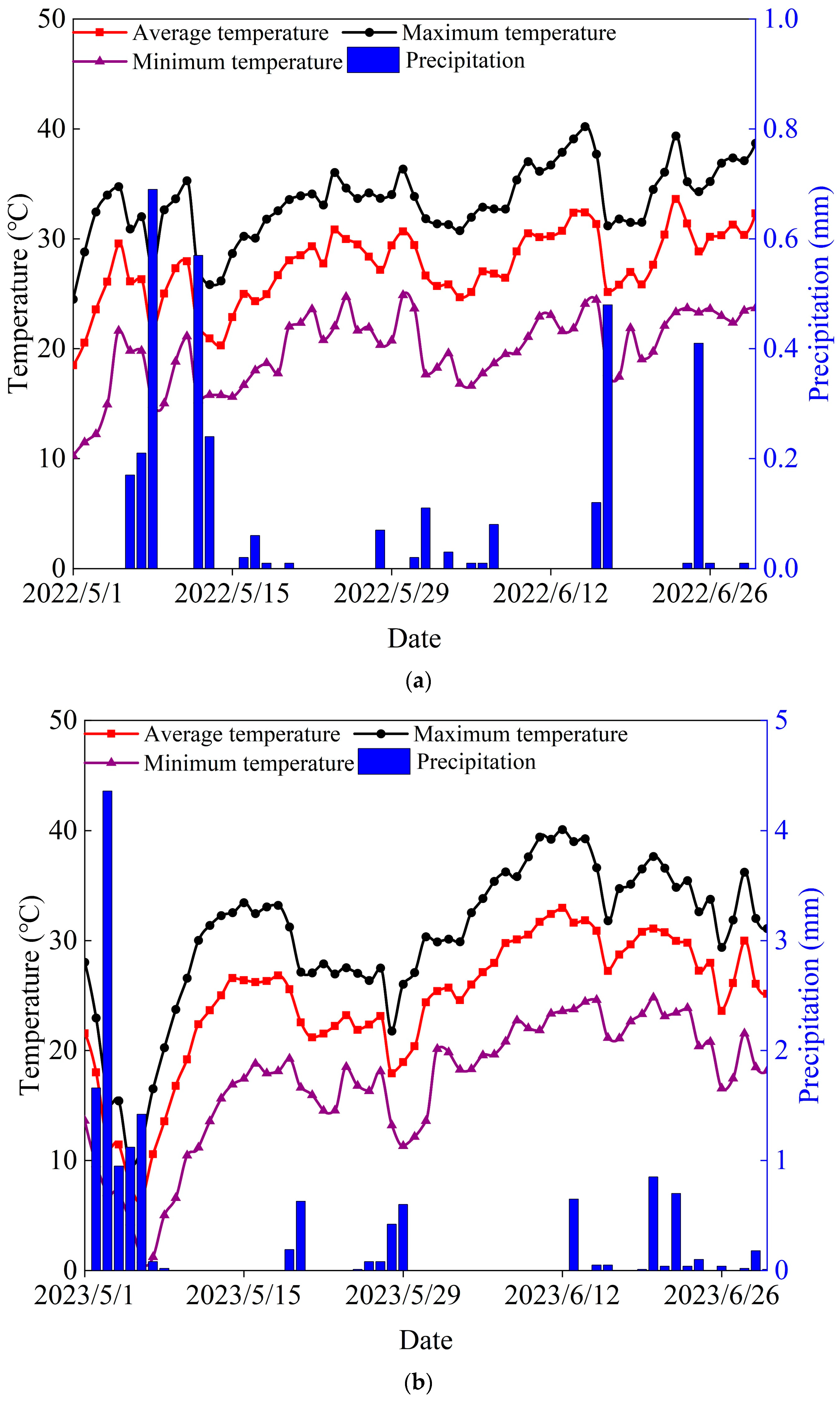
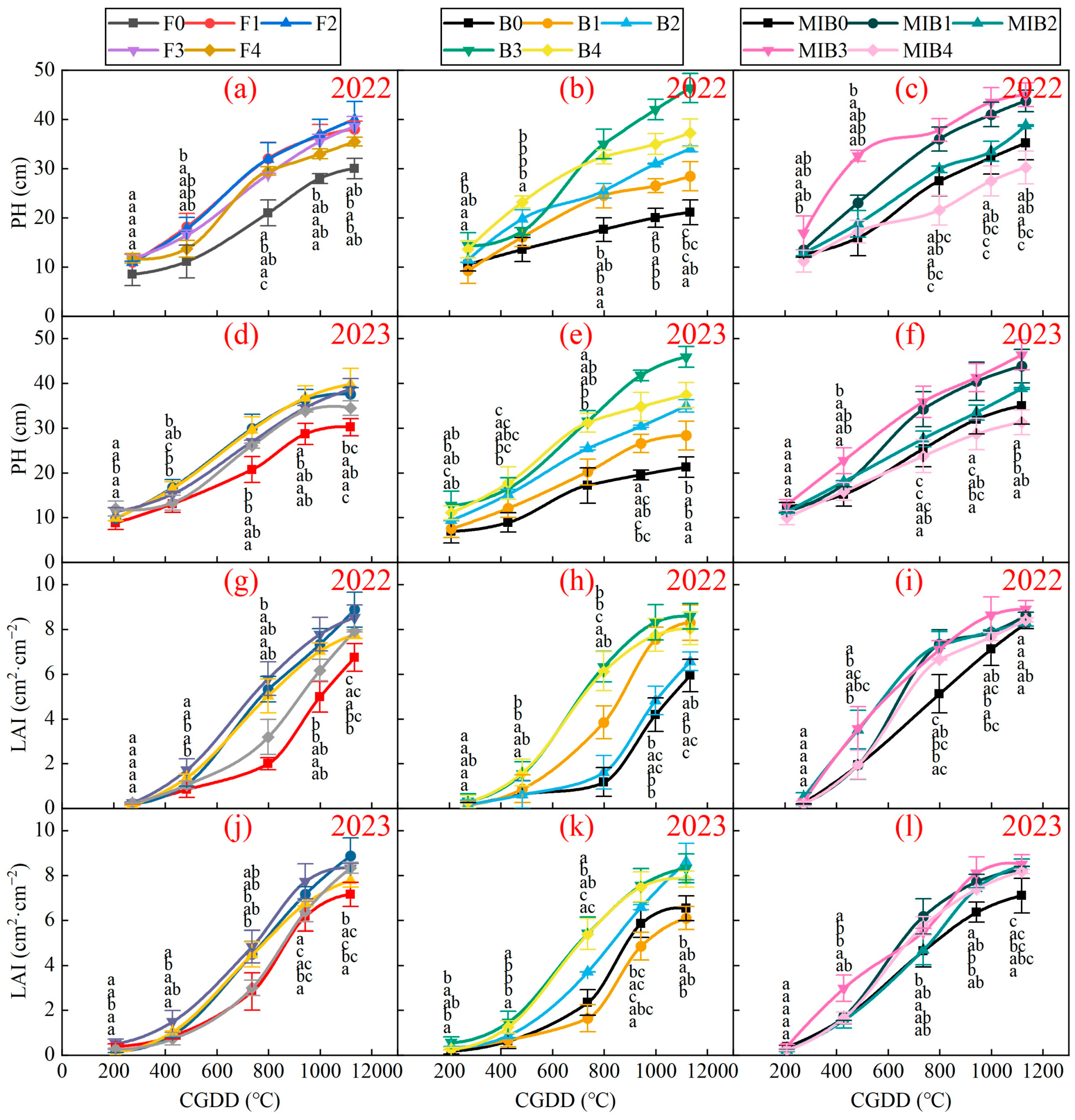

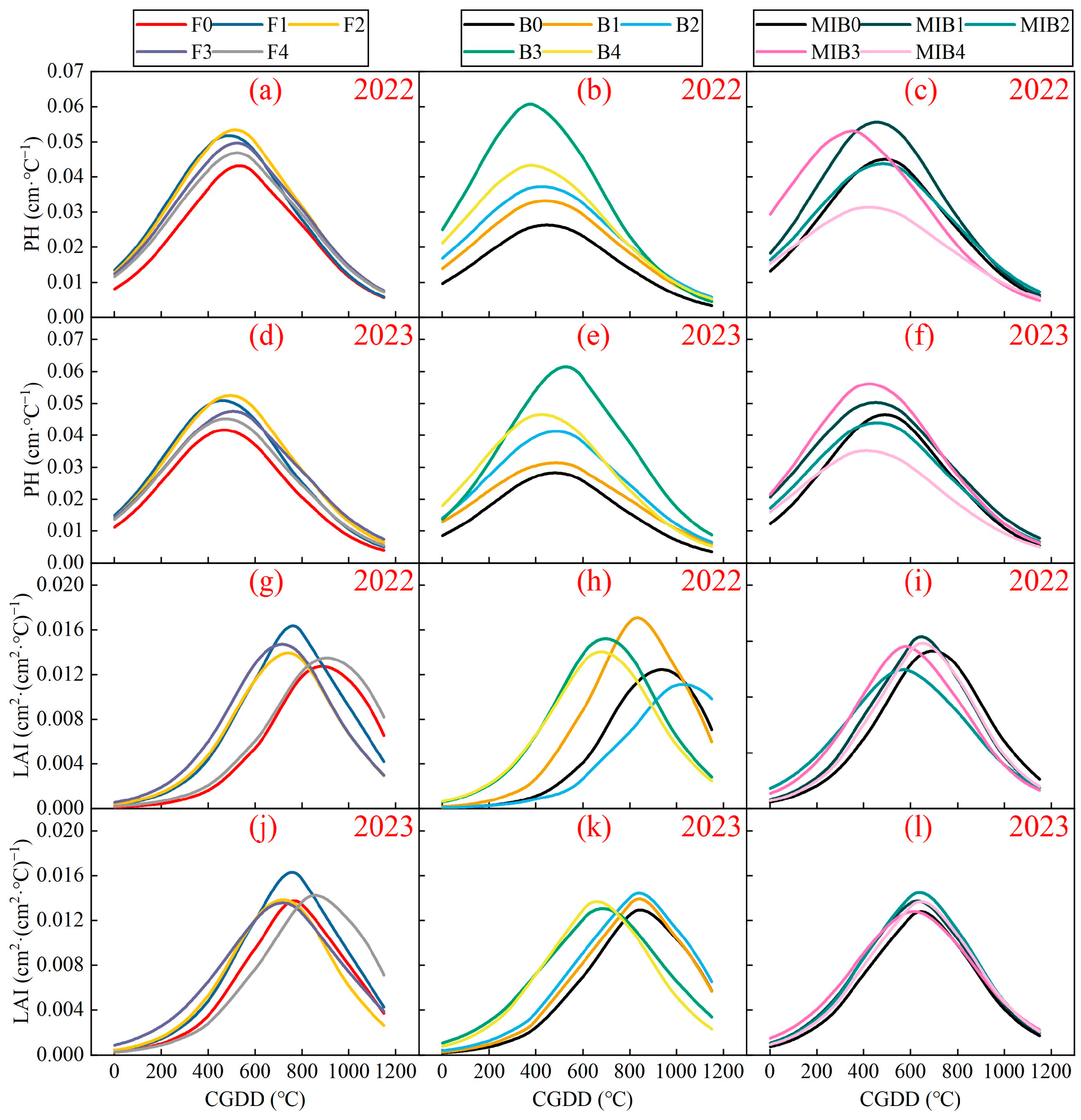

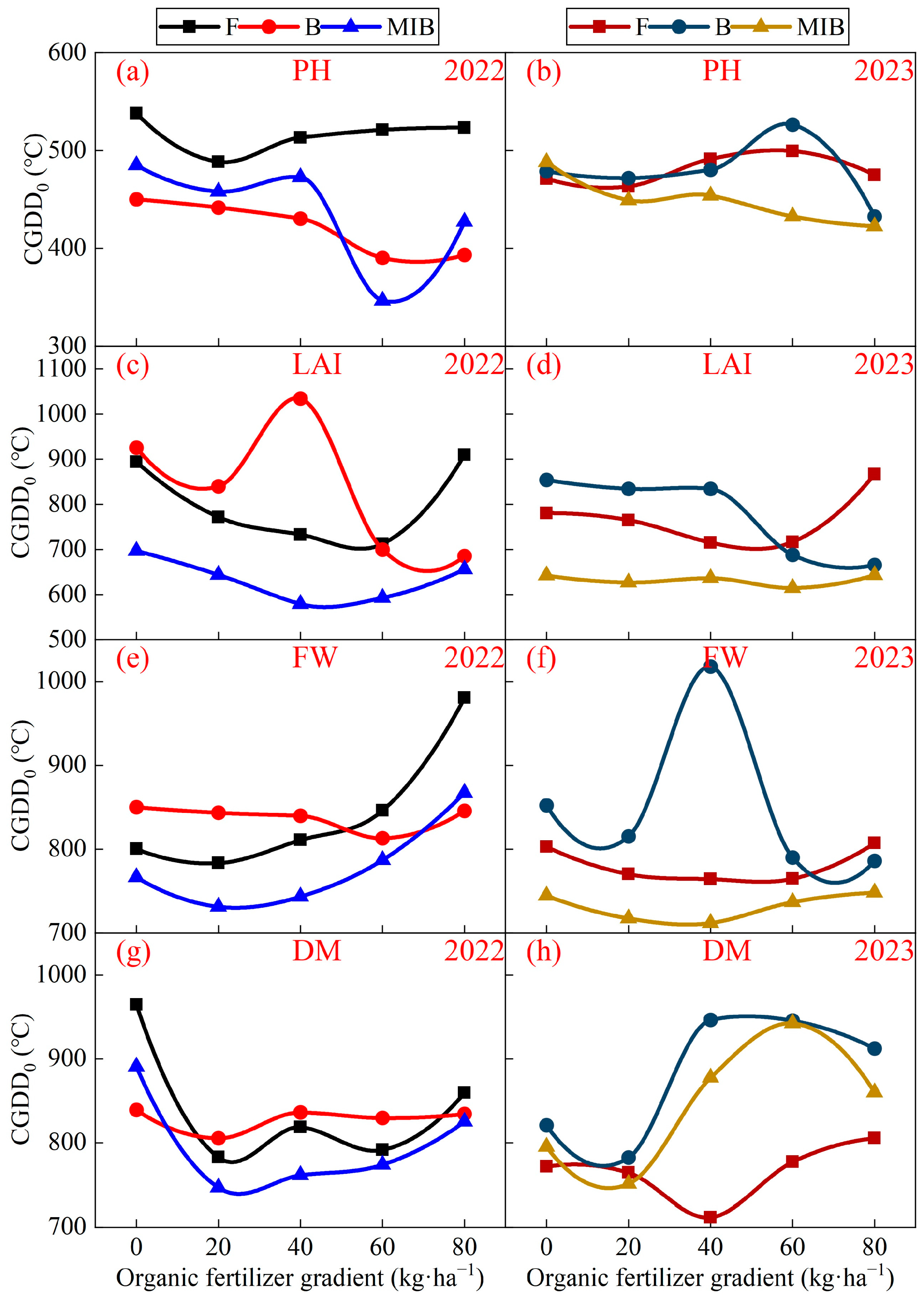
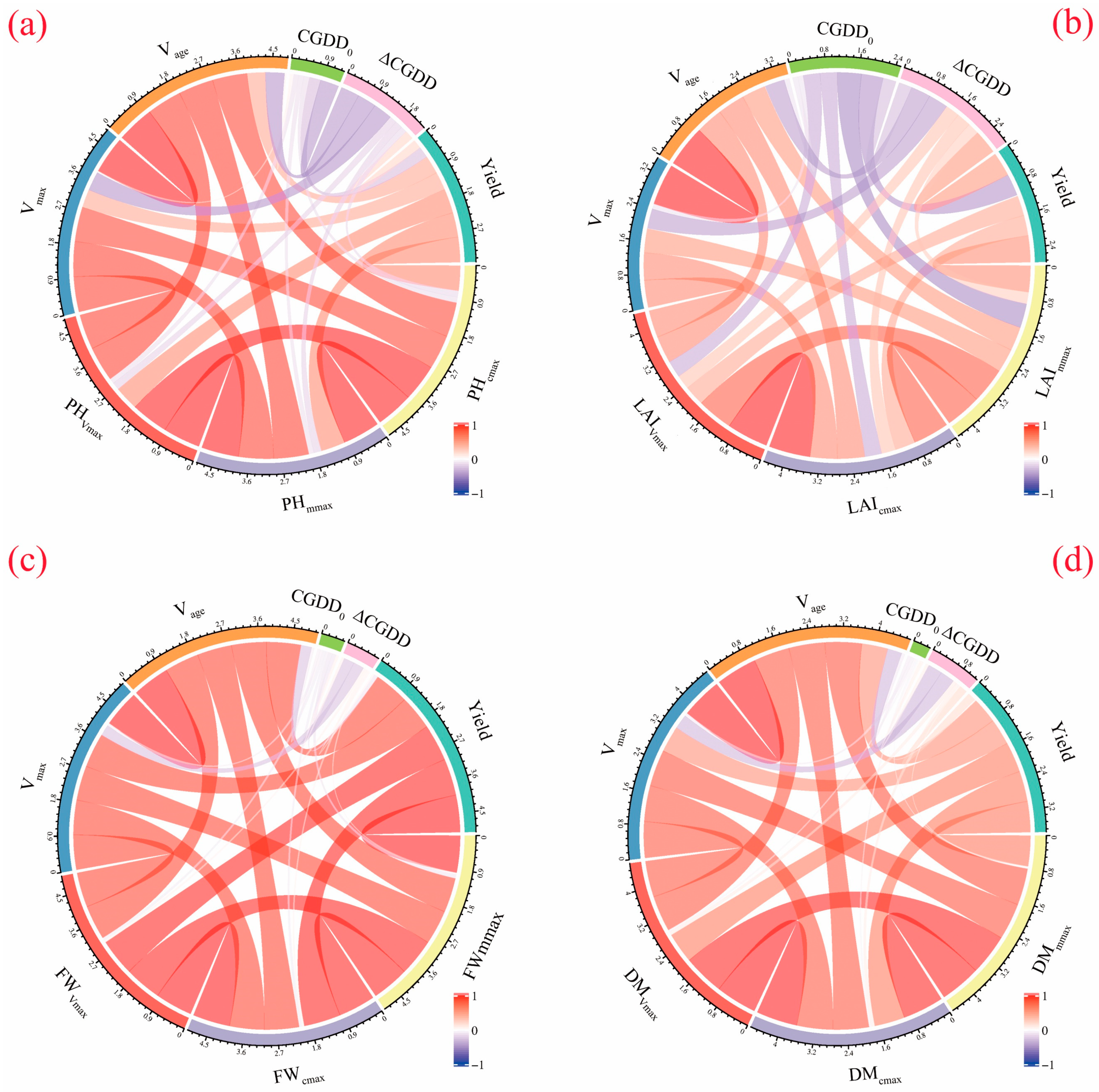
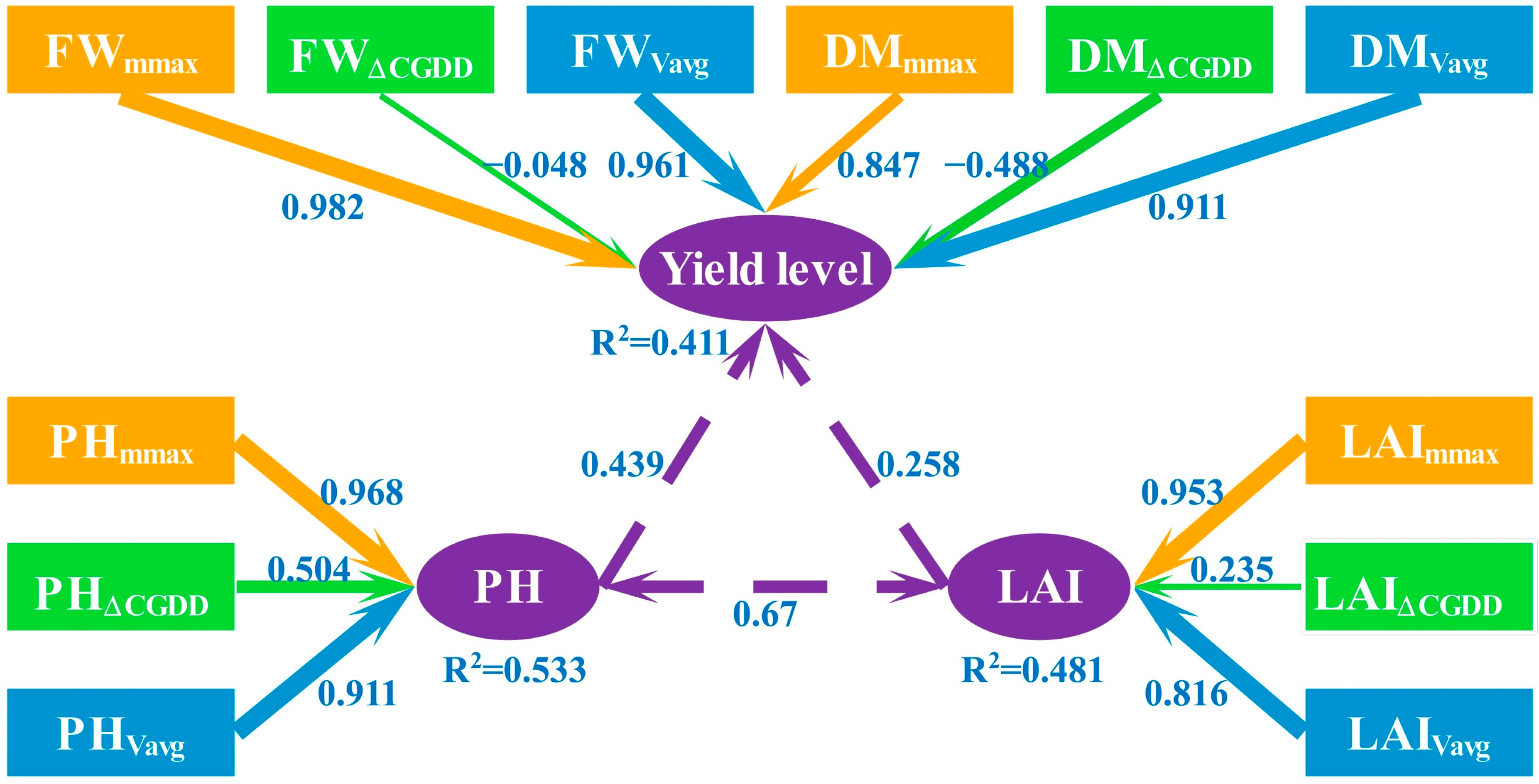
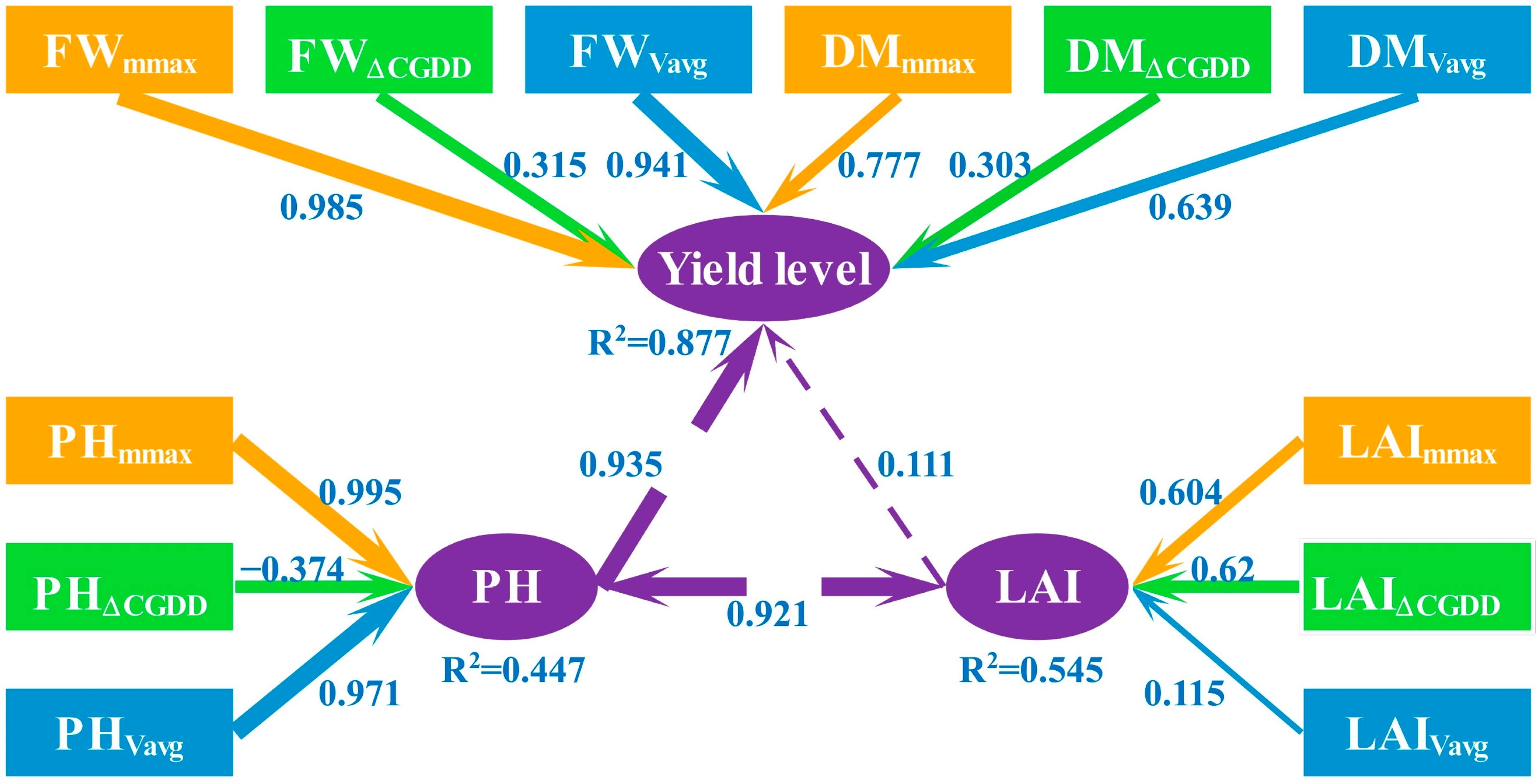

| Depth (cm) | Bulk Density (g·cm−3) | Mechanical Composition (%) | pH | Alkali-Hydrolyzed Nitrogen (mg·kg−1) | Available Phosphorus (mg·kg−1) | Available Potassium (mg·kg−1) | Organic Matter (g·kg−1) | ||
|---|---|---|---|---|---|---|---|---|---|
| Clay | Silt | Sand | |||||||
| 0–20 | 1.45 | 5.3 | 52.5 | 42.2 | 8.82 | 24.34 | 41.37 | 240 | 8.10 |
| 20–40 | 1.37 | 3.3 | 32.9 | 63.8 | 8.15 | 13.83 | 8.79 | 144 | 5.10 |
| Index | Treatment | 2022 | 2023 | ||||||
|---|---|---|---|---|---|---|---|---|---|
| Logistic Model | R2 | RMSE | nRMSE/% | Logistic Model | R2 | RMSE | nRMSE/% | ||
| PH | F0 | 0.958 | 1.888 | 9.57 | 0.954 | 2.028 | 9.99 | ||
| F1 | 0.993 | 1.152 | 4.25 | 0.990 | 1.443 | 5.54 | |||
| F2 | 0.989 | 1.544 | 5.61 | 0.985 | 1.804 | 6.81 | |||
| F3 | 0.969 | 2.405 | 9.18 | 0.959 | 2.467 | 9.74 | |||
| F4 | 0.957 | 2.276 | 9.22 | 0.928 | 2.347 | 9.81 | |||
| B0 | 0.984 | 0.650 | 3.93 | 0.977 | 1.124 | 7.62 | |||
| B1 | 0.998 | 0.420 | 2.00 | 0.977 | 1.586 | 8.38 | |||
| B2 | 0.966 | 1.934 | 7.95 | 0.980 | 1.745 | 7.57 | |||
| B3 | 0.952 | 3.053 | 9.85 | 0.953 | 2.895 | 9.76 | |||
| B4 | 0.997 | 0.617 | 2.18 | 0.992 | 1.170 | 4.43 | |||
| MIB0 | 0.959 | 2.314 | 9.37 | 0.942 | 2.362 | 9.85 | |||
| MIB1 | 0.993 | 1.214 | 3.86 | 0.984 | 2.068 | 7.03 | |||
| MIB2 | 0.970 | 2.124 | 7.94 | 0.967 | 2.351 | 9.09 | |||
| MIB3 | 0.962 | 2.561 | 7.28 | 0.987 | 1.790 | 5.63 | |||
| MIB4 | 0.940 | 1.878 | 8.72 | 0.983 | 1.329 | 6.07 | |||
| LAI | F0 | 0.992 | 0.286 | 9.72 | 0.989 | 0.345 | 9.92 | ||
| F1 | 0.996 | 0.295 | 6.45 | 0.999 | 0.156 | 3.60 | |||
| F2 | 0.999 | 0.125 | 2.94 | 0.999 | 0.094 | 2.34 | |||
| F3 | 0.999 | 0.148 | 3.09 | 0.996 | 0.256 | 5.61 | |||
| F4 | 0.996 | 0.244 | 6.58 | 0.999 | 0.133 | 3.56 | |||
| B0 | 0.986 | 0.235 | 9.78 | 0.983 | 0.305 | 9.86 | |||
| B1 | 0.996 | 0.276 | 6.66 | 0.979 | 0.262 | 9.70 | |||
| B2 | 0.992 | 0.265 | 9.63 | 0.999 | 0.095 | 2.36 | |||
| B3 | 0.996 | 0.273 | 5.44 | 0.997 | 0.237 | 5.09 | |||
| B4 | 0.995 | 0.286 | 6.02 | 0.995 | 0.298 | 6.70 | |||
| MIB0 | 0.993 | 0.330 | 7.28 | 0.999 | 0.133 | 3.32 | |||
| MIB1 | 0.984 | 0.509 | 9.79 | 0.994 | 0.330 | 6.85 | |||
| MIB2 | 0.977 | 0.531 | 9.66 | 0.998 | 0.207 | 4.65 | |||
| MIB3 | 0.984 | 0.545 | 9.57 | 0.980 | 0.506 | 9.95 | |||
| MIB4 | 0.992 | 0.369 | 7.42 | 0.997 | 0.234 | 5.05 | |||
| Index | Treatment | 2022 | 2023 | ||||||
|---|---|---|---|---|---|---|---|---|---|
| Logistic Model | R2 | RMSE | nRMSE/% | Logistic Model | R2 | RMSE | nRMSE/% | ||
| FW | F0 | 0.965 | 2020.0 | 14.78 | 0.995 | 906.4 | 8.38 | ||
| F1 | 0.984 | 2083.0 | 11.36 | 0.994 | 1680.0 | 9.18 | |||
| F2 | 0.973 | 3515.0 | 14.56 | 0.994 | 2066.0 | 8.31 | |||
| F3 | 0.999 | 1481.0 | 4.26 | 0.998 | 1816.0 | 5.42 | |||
| F4 | 0.937 | 3214.0 | 14.58 | 0.982 | 4037.0 | 14.92 | |||
| B0 | 0.961 | 1424.0 | 14.18 | 0.992 | 1076.0 | 10.86 | |||
| B1 | 0.988 | 1278.0 | 12.50 | 0.988 | 1404.0 | 13.55 | |||
| B2 | 0.995 | 1758.0 | 8.10 | 0.973 | 3043.0 | 14.22 | |||
| B3 | 0.996 | 2328.0 | 7.15 | 0.994 | 2621.0 | 8.85 | |||
| B4 | 0.976 | 2529.0 | 9.80 | 0.994 | 2444.0 | 8.80 | |||
| MIB0 | 0.991 | 1193.0 | 11.49 | 0.999 | 521.2 | 4.66 | |||
| MIB1 | 0.994 | 2152.0 | 7.55 | 0.997 | 1518.0 | 5.59 | |||
| MIB2 | 0.984 | 4336.0 | 13.12 | 0.998 | 1503.0 | 5.03 | |||
| MIB3 | 0.994 | 3199.0 | 8.07 | 0.988 | 4554.0 | 12.11 | |||
| MIB4 | 0.996 | 2194.0 | 7.44 | 0.983 | 4780.0 | 14.48 | |||
| DM | F0 | 0.994 | 88.0 | 8.29 | 0.976 | 135.1 | 14.22 | ||
| F1 | 0.983 | 392.9 | 12.81 | 0.979 | 226.6 | 12.92 | |||
| F2 | 0.990 | 189.7 | 10.53 | 0.987 | 322.4 | 11.43 | |||
| F3 | 0.988 | 387.3 | 11.52 | 0.984 | 464.6 | 14.33 | |||
| F4 | 0.998 | 129.7 | 5.81 | 0.963 | 320.6 | 14.83 | |||
| B0 | 0.987 | 112.0 | 12.11 | 0.957 | 123.1 | 14.85 | |||
| B1 | 0.997 | 130.4 | 6.70 | 0.981 | 122.9 | 12.75 | |||
| B2 | 0.965 | 133.0 | 14.74 | 0.993 | 192.2 | 9.72 | |||
| B3 | 0.996 | 157.0 | 6.09 | 0.974 | 378.8 | 14.97 | |||
| B4 | 0.996 | 157.6 | 7.43 | 0.979 | 327.8 | 14.72 | |||
| MIB0 | 0.999 | 101.4 | 3.91 | 0.996 | 123.7 | 7.27 | |||
| MIB1 | 0.984 | 358.5 | 11.58 | 0.990 | 254.6 | 11.44 | |||
| MIB2 | 0.993 | 341.9 | 8.48 | 0.987 | 455.3 | 14.59 | |||
| MIB3 | 0.994 | 407.3 | 8.40 | 0.984 | 618.7 | 13.69 | |||
| MIB4 | 0.990 | 152.2 | 9.54 | 0.993 | 347.3 | 9.15 | |||
Disclaimer/Publisher’s Note: The statements, opinions and data contained in all publications are solely those of the individual author(s) and contributor(s) and not of MDPI and/or the editor(s). MDPI and/or the editor(s) disclaim responsibility for any injury to people or property resulting from any ideas, methods, instructions or products referred to in the content. |
© 2023 by the authors. Licensee MDPI, Basel, Switzerland. This article is an open access article distributed under the terms and conditions of the Creative Commons Attribution (CC BY) license (https://creativecommons.org/licenses/by/4.0/).
Share and Cite
Lin, S.; Wang, C.; Lei, Q.; Wei, K.; Wang, Q.; Deng, M.; Su, L.; Liu, S.; Duan, X. Effects of Combined Application of Organic Fertilizer on the Growth and Yield of Pakchoi under Different Irrigation Water Types. Agronomy 2023, 13, 2468. https://doi.org/10.3390/agronomy13102468
Lin S, Wang C, Lei Q, Wei K, Wang Q, Deng M, Su L, Liu S, Duan X. Effects of Combined Application of Organic Fertilizer on the Growth and Yield of Pakchoi under Different Irrigation Water Types. Agronomy. 2023; 13(10):2468. https://doi.org/10.3390/agronomy13102468
Chicago/Turabian StyleLin, Shudong, Chunhong Wang, Qingyuan Lei, Kai Wei, Quanjiu Wang, Mingjiang Deng, Lijun Su, Shiyao Liu, and Xiaoxian Duan. 2023. "Effects of Combined Application of Organic Fertilizer on the Growth and Yield of Pakchoi under Different Irrigation Water Types" Agronomy 13, no. 10: 2468. https://doi.org/10.3390/agronomy13102468






